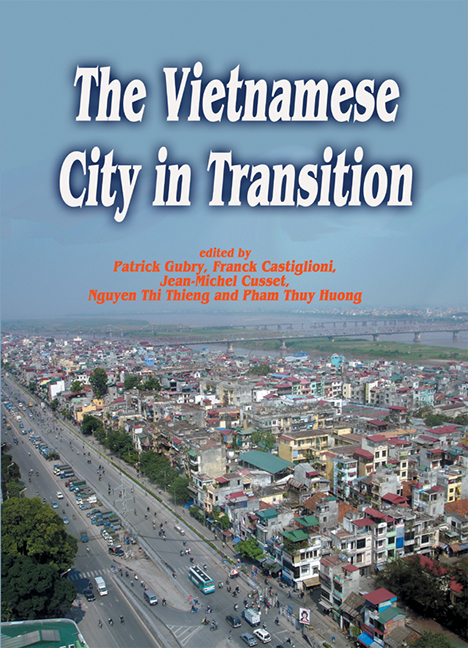Book contents
- Frontmatter
- Contents
- List of Tables
- List of Figures
- List of Colour Plates
- Foreword
- Acknowledgments
- List of Acronyms
- The Editors
- The Contributors
- Introduction: Urban Research in Action: Context, Aims, Directions
- 1 Urban Transition in Vietnam: Its Processes and Stakeholders
- 2 Road System and Urban Recomposition in Hanoi
- 3 Intra-Urban Mobility in Ho Chi Minh City and Hanoi
- 4 Resettlement Issues of Informal Settlement Areas in Ho Chi Minh City: From Large-scale Programmes to Micro-projects
- 5 Changes in Public Water Management: Transition, Compromise, and Innovation
- 6 The Role of Civil Society in Urban Environmental Management
- 7 Assessment of Projects Supported by Official Development Assistance Based on Partnership Formats: From Ho Chi Minh City to Hanoi
- 8 Relations between International Consultants and the Local Engineering Force in Urban Infrastructures
- 9 Conclusion: A Diverse Approach to Research on Urban Issues
- General Bibliography
- Index
- Plate Section
2 - Road System and Urban Recomposition in Hanoi
Published online by Cambridge University Press: 21 October 2015
- Frontmatter
- Contents
- List of Tables
- List of Figures
- List of Colour Plates
- Foreword
- Acknowledgments
- List of Acronyms
- The Editors
- The Contributors
- Introduction: Urban Research in Action: Context, Aims, Directions
- 1 Urban Transition in Vietnam: Its Processes and Stakeholders
- 2 Road System and Urban Recomposition in Hanoi
- 3 Intra-Urban Mobility in Ho Chi Minh City and Hanoi
- 4 Resettlement Issues of Informal Settlement Areas in Ho Chi Minh City: From Large-scale Programmes to Micro-projects
- 5 Changes in Public Water Management: Transition, Compromise, and Innovation
- 6 The Role of Civil Society in Urban Environmental Management
- 7 Assessment of Projects Supported by Official Development Assistance Based on Partnership Formats: From Ho Chi Minh City to Hanoi
- 8 Relations between International Consultants and the Local Engineering Force in Urban Infrastructures
- 9 Conclusion: A Diverse Approach to Research on Urban Issues
- General Bibliography
- Index
- Plate Section
Summary
City and Projects: Trends
A City in Motion
The millennial city of Hanoi is a new city. This apparent paradox reflects the Vietnamese capital's drastic transformation, in the space of a few years, from a small town into a rapidly expanding metropolis. This is a brief and concise account of that evolution, as observed over a period of several years by an architect interested in its architecture and its neighbourhoods and a geographer-urbanist researcher who has undertaken several assignments in the city since the country opened to market economy in 1986. These observations are based on meticulous data collected in situ and supported by numerous interviews with urban property developers and users, investors, and urban planning decision-makers and professionals. The collected data are compared with existing archives and publications and complemented by available censual data which has been refined and revised through periodic visits in the field; sectoral research by architecture students has also been of great value. These are not the results of inconclusive hard data surveys, but analyses based on an in-depth knowledge of the city, which we have covered time and again on foot, by bicycle and on motorcycle — the most suitable means of transportation for the early twenty-first century Hanoian.
Besides the city's architectural and urban evolution, we will also deal with the motivations that drive both private and official players in the areas of conservation and transformation, the two chief aspects that will determine the growth of the city. Indeed, Hanoi is facing some major and highly topical issues: respect of its urban and architectural heritage, and in particular built heritage and patterns of urban composition; the recognition of vibrant traditional customs practised by both previously established and newly arrived city dwellers; the improvement of living conditions for the general public, housing and appropriation through use of public space; control of urban growth and appearance of extensions, which make Hanoi the hub of an amazingly dynamic urban area.
- Type
- Chapter
- Information
- The Vietnamese City in Transition , pp. 33 - 62Publisher: ISEAS–Yusof Ishak InstitutePrint publication year: 2010



